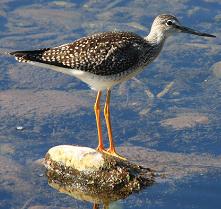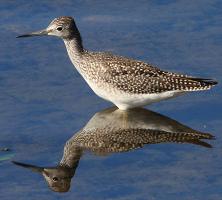Greater Yellowlegs 
Identification and Pictures
(Tringa melanoleuca)
Greater yellowlegs are a slim gray sandpiper,
12 1/2 to 15 inches, with black, white, and gray checkered back. As the name
implies it has long yellow legs. They have a white eye
ring and the under parts are
whitish. In breeding plumage they are heavily barred
below. The bill is long, and slightly upturned. The
white tail, barred at the end can be readily seen in
flight. Young birds look similar to the adults but are
not has heavily marked.
Like other birds in this genus they, bob their body up and
down.
The Lesser yellow legs looks similar but are
smaller, and have a slim straight bill.
Photos by Keith
Lee. The camera I use is the Canon
EOS 40D. Visit All-birds store

Greater Yellowlegs Sound
Males do a loud, ringing, whistled song.
Their call is a clear, squeaky whew-whew-whew.
sound
Preferred Habitat
Greater Yellowlegs breed in muskeg bogs in
Canada, and Alaska. In summer they can be seen in
streams, ponds, and marshes through out the U.S., while they
migrate south to the Atlantic, and Pacific coasts of the United States,
and to South America.
Breeding and Nesting
In courtship the male performs display
flights, gliding, rising, and falling while he does his loud
whistled song. They nest in depression on the ground, lined
with twigs, grass, leaves, and lichen. Females will lay
4 buff, blotched eggs which they incubate for around 23 days.
Soon after hatching the young birds are able to leave the
nest.
Food
In breeding season insects and insect larvae are their
primary food. During migration, and winter they feed on
fish, and other aquatic insects, and animals, swinging their
beaks back and forth in the water to stir up their prey.
To learn about other favorite
birds click here.

|
